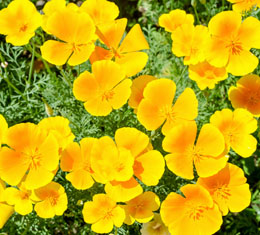Xeriscaping allows one to enjoy all the benefits and beauty of a conventional garden by being water-wise and cost-efficient. Here's more on this concept.

The word xeriscape is derived from the Greek word
xeros, which means dry, and the English word
scape, meaning a scene. Combining them, it means a dry scene. This form of gardening is often misunderstood for being a garden of desert flowers or just dry and arid gardening. However, the basic principle of xeriscape gardening is conservation of water and soil improvement using drought tolerant plants and shrubs.
Planning and Design
Planning a garden is the most basic requirement of any form of a garden. In xeriscape gardening, one must pay attention to the type of soil and its water requirement. Plants with similar water needs should be grouped and planted in the same beds. Designing should include reduction in the size of the turf area, and should be done keeping in mind the functionality and visual appeal of the garden.
Soil Improvement
Proper leveling of the ground will allow the water to be absorbed in the ground immediately, rather than running down or accumulating in some place. The soil should not only absorb water, but should also be capable of retaining and being well-drained at the same time. Good drainage of water can be achieved by adding organic composite, and, if possible, changing the soil in some places. Clay and sand soil have properties that suit xeriscaping. Composite should not be added to areas dedicated for succulents and cacti.
Planting
This form of gardening need not be restricted to just drought tolerant plants. Its basic idea is to conserve water. Moisture-loving plants can be grouped together in a low-lying area, that retains water more easily. If you are planting trees, its best to purchase dwarf varieties, like acacia, fig, olive, palm, or from the family of conifer trees. Shrubs and bushes like potentilla, oleander, and Texas sage grow well with very little water.
Designing smaller lawns with various drought resistant ornamental grasses will add appeal to your garden and save a lot of water, as these grasses don't require frequent watering. One can use any of the following ornamental grasses; purple fountain, switch variety, yellow pampas, blue oat, etc. Adding the element of a rock garden, with succulents such as Delosperma cooperi, red, orange, yellow aloe species, etc. and different colored rocks with vivid shaped cacti will add to the visual appeal of the garden. One can plan from the following list of drought resistant flowering plants, keeping its colors, height, and water requirement in mind; California poppy, cosmos, gomphrena, coreopsis, iris, gaillardia, marigold, cornflowers, etc.
Care and Maintenance
The flower and shrub beds should be covered with mulch, which is a composition of decaying raked leaves, wood barks, composite, etc. Mulch helps retain moisture in the soil, control weed growth, and slowly release nutrients to the plant roots over time. Plants should be adequately watered, and a system of drip-irrigation should be worked out to ensure no water wastage. A regular check for pests should be done, though most drought-resistant plants are natural pest and insect repellents.
As water becomes an expensive and scarce resource in most urban places of America, creating a garden based on xeriscape's most basic principle of water conservation makes more sense. One can enjoy a variety of trees, shrubs, and flowers even while facing a water shortage, by just being water smart.






 The word xeriscape is derived from the Greek word xeros, which means dry, and the English word scape, meaning a scene. Combining them, it means a dry scene. This form of gardening is often misunderstood for being a garden of desert flowers or just dry and arid gardening. However, the basic principle of xeriscape gardening is conservation of water and soil improvement using drought tolerant plants and shrubs.
The word xeriscape is derived from the Greek word xeros, which means dry, and the English word scape, meaning a scene. Combining them, it means a dry scene. This form of gardening is often misunderstood for being a garden of desert flowers or just dry and arid gardening. However, the basic principle of xeriscape gardening is conservation of water and soil improvement using drought tolerant plants and shrubs.